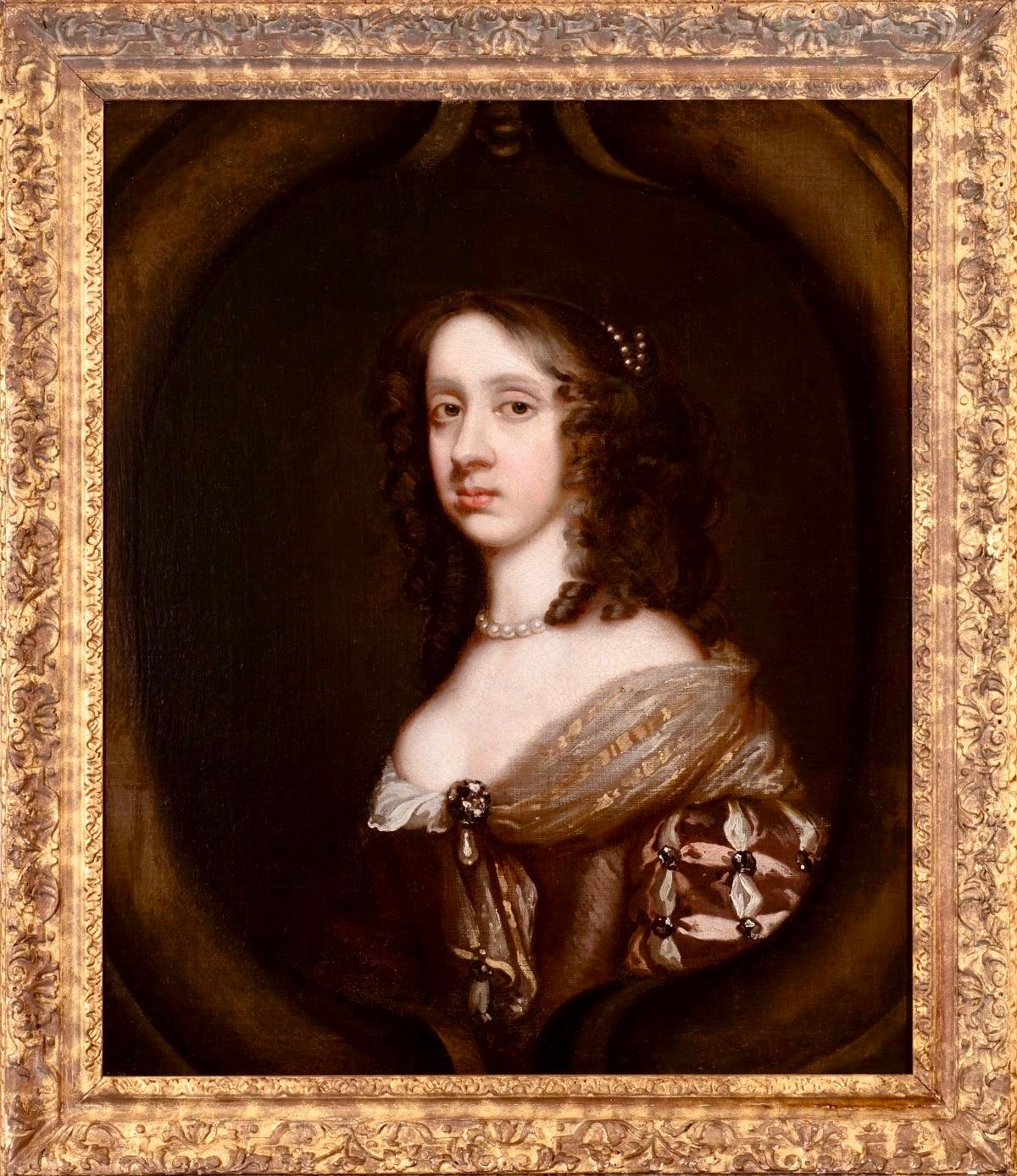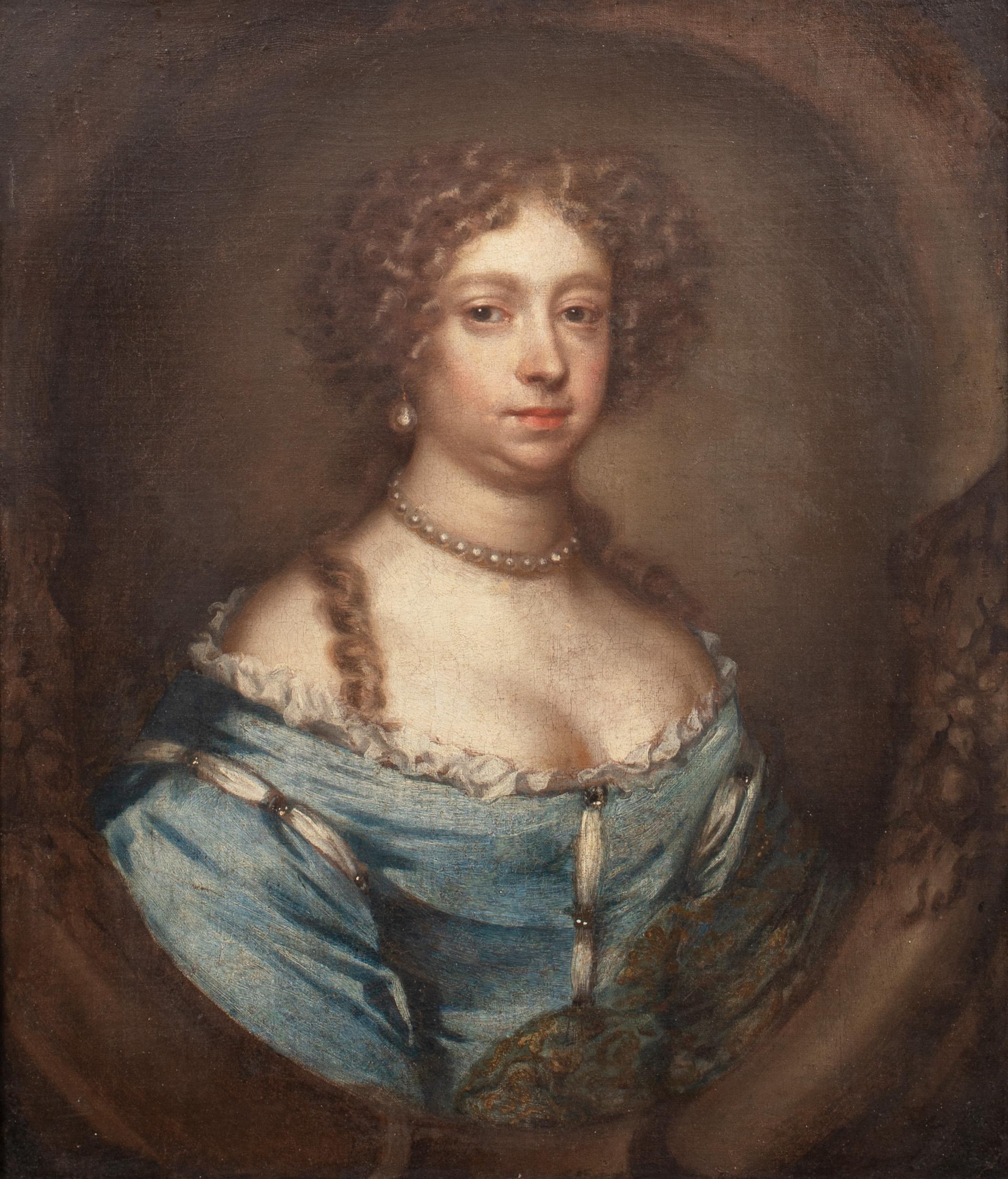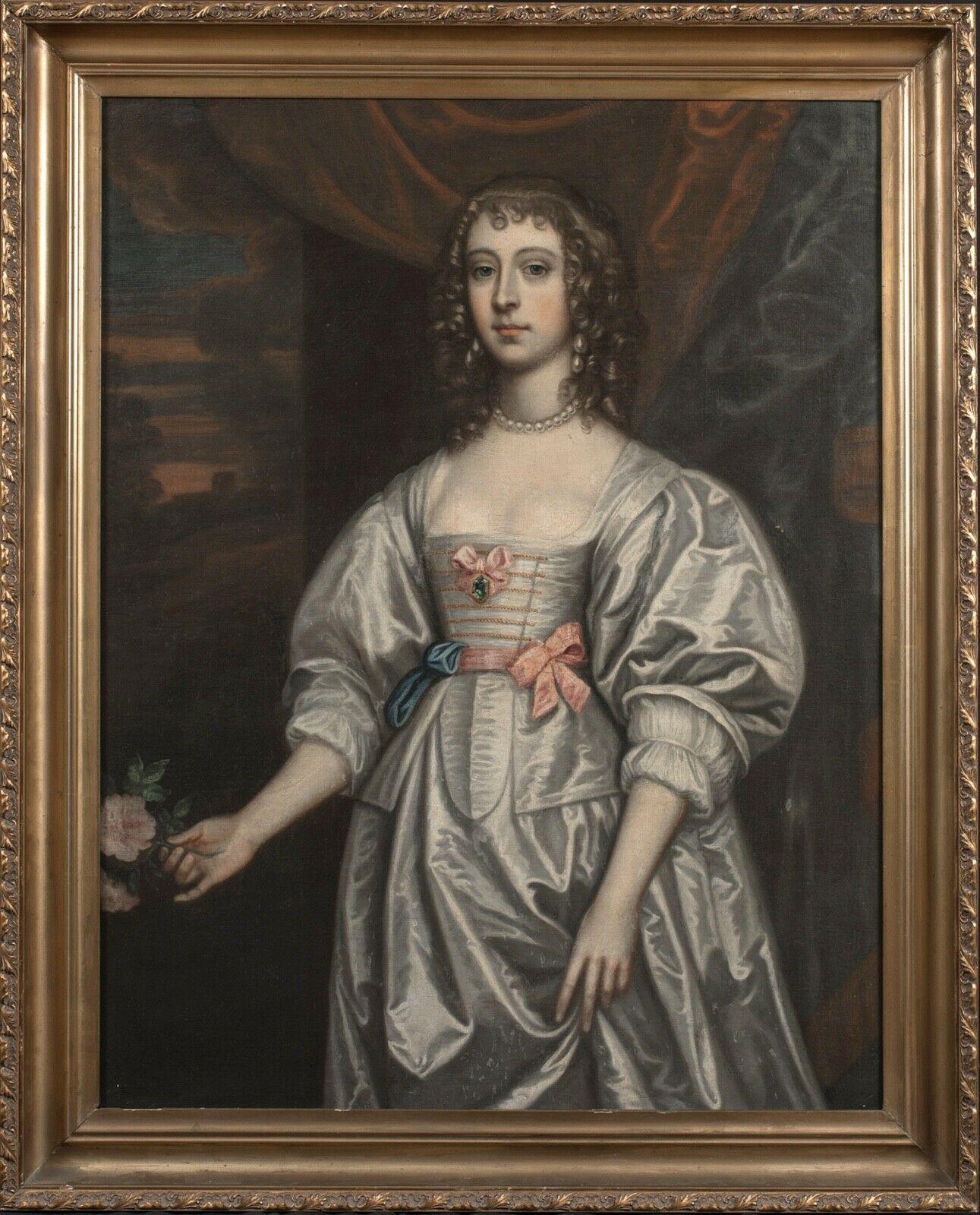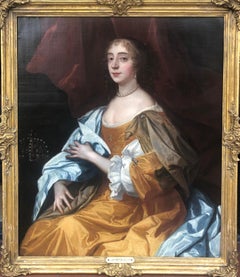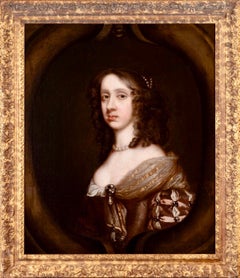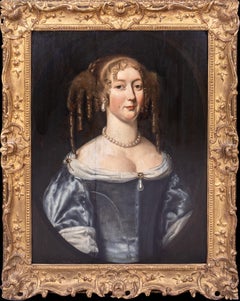Items Similar to Portrait of Anne, Lady Russell, later Countess of Bedford
Want more images or videos?
Request additional images or videos from the seller
1 of 8
Portrait of Anne, Lady Russell, later Countess of Bedfordc. 1635
c. 1635
$260,262.79
£190,000
€222,905.45
CA$356,507.97
A$397,546.72
CHF 207,422.94
MX$4,878,048.17
NOK 2,640,163.49
SEK 2,501,497.57
DKK 1,663,625.76
Shipping
Retrieving quote...The 1stDibs Promise:
Authenticity Guarantee,
Money-Back Guarantee,
24-Hour Cancellation
About the Item
A three-quarter length portrait of Anne, Lady Russell, later Countess of Bedford (1615-1684), in a blue dress. Attributed to Sir Anthony Van Dyck.
Anne Carr, Lady Russell, an esteemed beauty was clearly a favourite of Sir Anthony Van Dyck. There are six portrait types of Lady Russell listed in Miller, et al. It is tempting to associate the current portrait with the three-quarter length in blue in the Egremont collection at Petworth House (Millar IV.22) because of the similarity of colouring. However, we believe that this picture represents a different portrait type, and most likely derives from a separate sitting. The comparison with the short three-quarter length belonging to the Tokyo Fuji Art Museum, Tokyo (Millar IV.23), is telling. The heads are essentially the same, though the pose and the colouring of the portraits are quite different. The Japanese painting features a rose-red gown and a fawn stole, possibly darker than in this painting. This comparison also illustrates Van Dyck's ability to develop different compositions from a single sitting.
Dr. Malcolm Rogers CBE FSA believes this painting to be an unfinished work by the artist:
"with, as you might expect, preparatory work by a member of his studio. Especially encouraging is the penumbra of thicker paint around the lady's head which is a recognised feature associated with the artist's ad vivum rendering of heads. My notes do not mention a similar penumbra in the Tokyo painting, though the painting is throughout of very high quality. There are one or two slight pentimenti in the silhouette of the figure of your painting and in the line of her stole, which at one point may have been intended to run over her right wrist. Close examination may reveal more. Some areas of the draperies, especially the linens are not fully realised, and, of course, the background is only roughed in.
Millar suggests that the Tokyo painting with its loose gown and protective hands may indicate that the sitter is pregnant. The gown is similarly loose in [this] painting. If she is indeed pregnant this might suggest a date around 1638 or 1639, in which years the first two of her eleven children were born. I cannot explain why the painting was left unfinished, but it is, must be, a distinct possibility that this is the very portrait of Lady Bedford that remained in Van Dyck's studio at the time of his death (see C. Brown and N. Ramsay, 'Van Dyck's Collection: Some New Documents', Burlington Magazine, Vol. 132, pp. 704-9)."
We are immensely grateful to Dr. Malcolm Rogers CBE FSA.
Dimensions:
53. 125 in (H) x 43. 25 in (W)
Provenance:
Picture probably listed in contents of van Dyck’s studio at time of death December 1641 (O. Millar, Van Dyck, A complete catalogue of the paintings, New Haven and London, 2004, under no. IV.23);
The most Reverand Dean of Durham, possibly William Lake (1817-1897);
Charles Sedelmeyer, 1906, as 'Sir Anthony van Dyck';
Colonel Edward F Simms of Kentucky;
H. Kenneth Franzheim;
Kenneth Franzheim II;
Thence by descent to Sabrina Franzheim (current owner).
- Attributed to:Anthony van Dyck (1599 - 1641, Flemish)
- Creation Year:c. 1635
- Dimensions:Height: 53.125 in (134.94 cm)Width: 43.25 in (109.86 cm)
- Medium:
- Period:
- Condition:
- Gallery Location:London, GB
- Reference Number:1stDibs: LU673311550112
About the Seller
5.0
Vetted Professional Seller
Every seller passes strict standards for authenticity and reliability
Established in 1990
1stDibs seller since 2017
42 sales on 1stDibs
- ShippingRetrieving quote...Shipping from: London, United Kingdom
- Return Policy
Authenticity Guarantee
In the unlikely event there’s an issue with an item’s authenticity, contact us within 1 year for a full refund. DetailsMoney-Back Guarantee
If your item is not as described, is damaged in transit, or does not arrive, contact us within 7 days for a full refund. Details24-Hour Cancellation
You have a 24-hour grace period in which to reconsider your purchase, with no questions asked.Vetted Professional Sellers
Our world-class sellers must adhere to strict standards for service and quality, maintaining the integrity of our listings.Price-Match Guarantee
If you find that a seller listed the same item for a lower price elsewhere, we’ll match it.Trusted Global Delivery
Our best-in-class carrier network provides specialized shipping options worldwide, including custom delivery.More From This Seller
View AllPortrait of Bridget Drury Lady Shaw, formerly Viscountess Kilmorey
By Sir Peter Lely
Located in London, GB
Sir Peter Lely (Soest 1618 – 1680 London)
Portrait of lady with a crown, possibly Bridget Drury Lady Shaw, formerly Viscountess Kilmorey, later Lady Baber (d.1696) c.1665
Oil on canvas
46 1/2 x 40 3/4 inches, Framed
42 1/4 x 36 1/4 inches, Unframed
Inscribed left [……….]Isabella
James Mulraine wrote the following for this piece:
This portrait dates to the middle of the 1660s, the decade when Lely’s career took off as successor to Sir Anthony van Dyck. At the Restoration Charles II had appointed him Principal Painter to the King and paid a pension £200 per annum ‘as formerly to Sr. Vandyke...’1 Lely had trained in Haarlem and he was in his early twenties when he came to London in 1643. He was an astute businessman and a wise courtier. In 1650 he painted a portrait of Oliver Cromwell (Birmingham Museum and Art Gallery) while maintaining links with the Royalist exiles through the 1650s. He had arrived in England as a painter of small-scale portraits and lush scenes of nymphs in landscapes in a Dutch style. His experience of Van Dyck in English collections transformed his painting. His lavish and alluring vision of Arcadia exactly captured the spirit of the Court and as Principal Painter he dominated English portraiture for the next twenty years. Lely ran a highly efficient studio along Netherlandish lines, employing a team of specialists like the drapery painter John Baptist Gaspars and young artists-in-training like Nicolas de Largilliere. He had numerous rivals during that period, and by 1670 he had introduced numbered standard poses to speed up production, while collaborating with printmakers for further revenue and advertising. He died in 1680 of a stroke while painting, working to the last.
The portrait, painted at a date when Lely’s poses and execution were still individual and inventive shows a lady sitting at three-quarter length facing away from the viewer. She has begun to turn towards the viewer, a pose with a long pedigree in art, first used by Leonardo da Vinci in the Mona Lisa (Louvre). She steadies her blue drapery where it might slip from her arm with the movement, a flash of realism beautifully captured. Like Van Dyck, Lely painted his female sitters in a timeless costume rather than contemporary fashion, showing a loose gown and floating silk draperies. It presented the sitter as a classical ideal. The portrait would not date.
The saffron dress may be the work of a drapery painter but the brown scarf must be by Lely himself, and appears unfinished, broadly sketched in behind the shoulder. The delicate blue glaze and nervous highlights suggest shimmering translucence. Lely was a master of painting hands – his hand studies are marvels of drawing – and the lady’s hands are superb, exactly drawn, delicately modelled and expressive. The fidgety gestures, clutching the gown, fiddling with the edge of the scarf, give the portrait psychological bite, suggesting the personality behind the calm courtier’s expression, adding to the sense shown in the look of the eyes and mouth that the lady is about to speak. The portrait’s language is Vandykian. The inspiration comes directly from Van Dyck’s English portraits of women. Lely owned Van Dyck’s Portrait of Lady Elizabeth Thimbleby and Dorothy Viscountess Andover (National Gallery, London) and the sitter’s costume quotes Lady Andover’s saffron dress and brown scarf. But Lely paints a generation who sat nearer to the ground and through a dialogue of expression and gesture he shows sitters who are more flesh and blood than Van Dyck’s.
The background with a column and curtain is different to those shown in most of Lely’s portraits of women. They tend to include trees or fountains, with a glimpse of landscape. But there are other examples. A portrait of the King’s reigning mistress, Barbara Villiers Duchess of Cleveland...
Category
1660s Portrait Paintings
Materials
Oil
Lady Dormore - A 16th Century Portrait of a key member of Shakespeare's England
Located in London, GB
Lady Dormer, Mary Browne
c. 1592
oil on panel
35 x 29 inches, unframed;
41 x 34.75 inches, inc. frame
Inscribed 'Lady Dormore'
Mary married Henry Wriothesley, 2nd Earl of Southampton who gave birth to Henry Wriothesley, 3rd Earl of Southampton - one of the great figures in Shakespears"s circle and founder of the Virginia company, developers of Virginia USA.
Henry Wriothesley, born 6 October 1573 at Cowdray House, Sussex, was the only son of Henry Wriothesley, 2nd Earl of Southampton, by Mary Browne, the only daughter of Anthony Browne, 1st Viscount Montague, and his first wife, Jane Radcliffe.[5] He had two sisters, Jane, who died before 1573, and Mary (c. 1567 – 1607), who in June 1585 married Thomas Arundell, 1st Baron Arundell of Wardour.[6]
After his father's death, Southampton's mother married firstly, on 2 May 1595, as his second wife, Sir Thomas Heneage (d. 17 October 1595), Vice-Chamberlain of the Household, and secondly, between 5 November 1598 and 31 January 1599, Sir William Hervey. She died in November 1607.[7]
Early life
When his father died on 4 October 1581 Southampton inherited the earldom and landed income valued at £1097 6s per annum. His wardship and marriage were sold by the Queen to her kinsman, Charles, Lord Howard of Effingham, for £1000. According to Akrigg, Howard then "entered into some further agreement, of which no documentation can now be found, which transferred to Lord Burghley personally the custody and marriage of the young Earl, but left Howard holding his lands", and late in 1581 or early in 1582 Southampton, then eight years of age, came to live at Cecil House in the Strand.[8]
In October 1585, at age twelve, Southampton entered St John's College, Cambridge,[9] graduating M.A. on 6 June 1589.[10] His name was entered at the Gray's Inn legal society before he left the university, and he was admitted on 29 February 1588.[11]
On Southampton's 16th birthday, 6 October 1589, Lord Burghley noted Southampton's age in his diary, and by 1590 Burghley was negotiating with Southampton's grandfather, Anthony Browne, 1st Viscount Montague, and Southampton's mother, Mary, for a marriage between Southampton and Lord Burghley's eldest granddaughter, Elizabeth Vere, daughter of Burghley's daughter, Anne Cecil, and Edward de Vere...
Category
16th Century Old Masters Figurative Paintings
Materials
Oil
Portrait of an Italian Noblewoman
Located in London, GB
15th century, Italian
Circle of Antonio del Pollaiuolo (1429-1498)
Portrait of an Italian Noblewoman
Oil and tempura on poplar panel
With partial inscription: ALZETAPIN
Provenance:...
Category
15th Century and Earlier Renaissance Portrait Paintings
Materials
Oil, Tempera, Wood Panel
17th Century Oil Painting Portrait of a Young English Boy
By Gerard Soest
Located in London, GB
Gerard SOEST (1600 - 1681)
Portrait of a Young Boy
oil on canvas
35.5 x 30.5 inches inc. frame
Gerard Soest (circa 1600 – 11 February 1681), also known as Gerald Soest, was a portra...
Category
17th Century Old Masters Portrait Paintings
Materials
Oil
C19th Portrait Princesse de Joinville of Brazil - Spectacular fit for a palace
By Henri d'Ainecy Montpezat
Located in London, GB
Portrait of Princess de Joinville riding a Bay Horse
Henri d’Aincy, Le Comte Monpezat (French 1817-1859)
Painted circa 1837-9
oil on canvas
113 x 92 inches (including frame)
92 x 70 inches (unframed)
Provenance – from a private royal collection
This magnificent portrait depicts Princess de Joinville, the daughter of Pedro I, Emperor of Brazil and the King of Portugal. Through her illustrious family she was directly related Alexander III and Nicholas II of Russia and the Russian royal family, as well as to many of the great ruling families of Europe.
The work clearly confirms Monpezat as one of the most accomplished equestrian portrait painters in France in the early nineteenth century. In terms of scale, quality and dramatic power, it must surely be considered amongst his finest works. The stance of the powerful thoroughbred - in half rear - emphasises the calm nature and courage of the Princess.
Francisca of Brazil (1824-98) married a son of Louis Philippe I, the King of the French, and had three children. Born at the Imperial Palace of Saint Christopher, her youngest brother was the future Pedro II...
Category
1830s Old Masters Portrait Paintings
Materials
Oil
A Portrait of a Gentleman, thought to be Moses Diego Lopez Pereira
Located in London, GB
Austrian School, 18th Century
A Portrait of a Gentleman, thought to be Moses Diego Lopez Pereira, 1st Baron d’Aguilar, in an elaborate coat and a powdered wig
Oil on canvas
Provena...
Category
18th Century Paintings
Materials
Canvas, Oil
You May Also Like
17th century English portrait of a lady
By Willem Wissing
Located in Bath, Somerset
Portrait of a lady attributed to William Wissing, half-length, wearing a pearl necklace and an amber gown adorned with jewels to the bodice and sleeves, wit...
Category
17th Century Old Masters Portrait Paintings
Materials
Canvas, Oil
Portrait Of Elizabeth Percy, Countess of Northumberland (1646-1690) 17th Century
By Daniel Mytens
Located in Blackwater, GB
Portrait Of Elizabeth Percy, Countess of Northumberland (1646-1690), 17th Century
Studio of Jan MYTENS (1640-1670)
Large 17th portrait of Elizabeth Percy Countess of Northumberland, oil on panel. Excellent quality and condition portrait of the daughter of the Earl of Southampton and granddaughter of the Earl of Chichester. Percy came to fame in the 1660's as one of the Windsor Beauties in the court of Charles II. Presented in its original antique hand carved frame...
Category
17th Century Portrait Paintings
Materials
Oil, Wood Panel
$5,369 Sale Price
20% Off
Portrait Of Essex Finch, Countess Of Nottingham, 17th Century
By Sir Peter Lely
Located in Blackwater, GB
Portrait Of Essex Finch, Countess Of Nottingham, 17th Century
circle of Sir Peter LELY (1618-1680)
Large 17th Century English Old Master po...
Category
17th Century Portrait Paintings
Materials
Canvas, Oil
$6,355 Sale Price
20% Off
Portrait Of Lady Mary Villiers, later Duchess of Richmond as Saint Agnes
By Anthony van Dyck
Located in Blackwater, GB
Portrait Of Lady Mary Villiers, later Duchess of Richmond and Lennox (1622-1685), As Saint Agnes, 17th Century
after Anthony VAN DTCK (1599-1641)
Portrait Of Lady Mary Villiers, later Duchess of Richmond and Lennox, As Saint Agnes, oil on canvas. Excellent quality and condition three quarter length seated portrait of the Duchess as Saint Agnes holding a palm leaf, accompanied by the lamb and wearing a white satin dress...
Category
17th Century Portrait Paintings
Materials
Canvas, Oil
$16,437 Sale Price
20% Off
Portrait Of A Lady, Frances Bard (1646-1702) Mistress of The Duke Of Cumberland
By Anthony van Dyck
Located in Blackwater, GB
Portrait Of A Lady, Frances Bard (1646-1702) Mistress of Prince Rupert von de Pfalz, Duke of Cumberland (1619-1882)
follower of Anthony Van Dyck (1...
Category
Late 17th Century Old Masters Portrait Paintings
Materials
Oil
$10,520 Sale Price
20% Off
Portrait of Frances Howard Duchess of Richmond - Flemish Old Master oil painting
By Anthony van Dyck
Located in London, GB
This stunning Flemish Old Master portrait oil painting is attributed to circle of Anthony Van Dyck. Painted circa 1630, the sitter is Frances Stewart née Howard (1578 -1639) Duchess ...
Category
Early 17th Century Old Masters Portrait Paintings
Materials
Oil
$52,600 Sale Price
20% Off
More Ways To Browse
Antique Hand Paint Portrait
Silhouette Portrait
Antique Framed Silhouettes
Antique Picture Frames London
Dating Antique Picture Frames
Countess Painting
Anthony Lister
17th C Portrait
17th Century Dress
Anthony Charles
Antique Rogers
17th Century Lady Portrait
Antique Silhouette Portrait
Antique Silhouette Portraits
1906 Picture Frames
Charles Rogers
New Bedford Antique
Edward Russell
